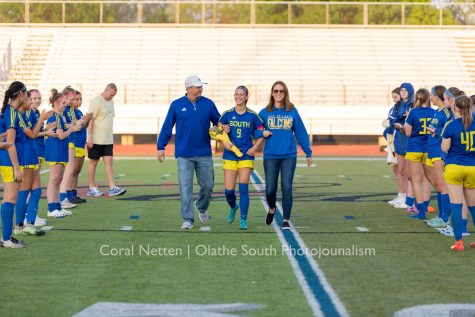Track and field athletes tailor training to events
May 11, 2016
Before the competition season can begin, an athlete must endure weeks of training to achieve prime physical condition.
Track and field requires weeks of training and conditioning before the competitions begin.
While traditional exercises are used to help participants with endurance, balance, strength and overall fitness, each event has its own unique training methods.
Overall, track and field has a total of 18 events: 11 for running and seven for field competitions.
Participants can compete in any of the 18 events as long as they do not exceed the four-event maximum per day.
Training depends on each event. Matt Bohm, track coach, acts as the head track coach. He’s coached almost all of the events and now oversees them along with the other assistant coaches.
The assistant coaches specialize in their own categories and help participants train and time themselves.
Assistant coaches include Damon Bell, SRO; Lauren Jaqua, English teacher; Graham Rees, science teacher; Ed Harbord, science teacher; Greg Wheeler, IT teacher; and Nathan Harrison, PE teacher.
“The assistant coaches work on different things with their par- ticipants. Each routine is struc- tured for the individual’s event and how they compete,” Bohm said.
For throwers, as in shot put, discus and similar fielding events, conditioning focuses on increasing flexibility and arm strength. They lift weights, stretch and practice form by test-throwing the different objects being thrown (discus, shot-put etc.).
Sprinters condition them- selves by working continuously, preparing their body for the strain
of a sprint. They sprint 50 and 100 meters, taking minimal breaks in order to build leg muscles.
Long distance runners work on building up distance and slicing down the time it takes to complete their runs.
For example, a distance run- ner might start with a nine-minute mile and, with constant training, they could narrow their mile time to seven or six minutes.
Though long distance runners work on endurance runs more often than sprinters do, endurance is still a key technique to any athlete. Breathing techniques, correct running form and posture are all beneficial habits to be taught to all runners.
Hurdlers, high jumpers and other similar events work on their own technical attributes. Jumpers will practice correct starting posi- tions and footwork pacing before the jump, for example.
According to Bohm, “90- 95 percent of all the track participants also compete in other sports” outside of track and field. “Only a few are specifically in track and field,” he said.
Most students will use the track season as a means of staying or getting into shape for their other sport(s).
While training methods differ for each unique evemt, each one benefits the person’s health, strength and flexibility.









